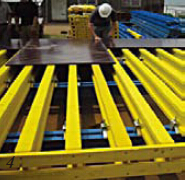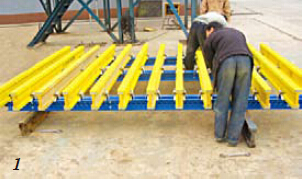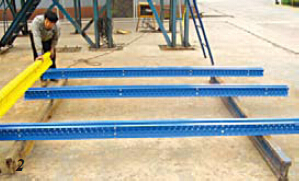Timber-beam Plywood Formwork For building Construction
- Loading Port:
- Tianjin
- Payment Terms:
- TT OR LC
- Min Order Qty:
- 50 m²
- Supply Capability:
- 1000 m²/month
OKorder Service Pledge
Quality Product, Order Online Tracking, Timely Delivery
OKorder Financial Service
Credit Rating, Credit Services, Credit Purchasing
You Might Also Like
Plywood --- make perfect concrete surface
WISA-Form Birch is a coated special plywood using in the formwork systems where high
requirements are set on the concrete surface and the times of reuses.
With CNBM timber beam & WISA plywood, the formwork is low weight but high load capacity, it is
widely used in construction.
Characteristics:
◆ Component with high standardization.
◆ Assembling in site, flexible application.
◆ Light weight, easy transportation and storage.



- Q:Can steel formwork be used in areas with high wind loads?
- Yes, steel formwork can be used in areas with high wind loads. Steel formwork is known for its strength, durability, and stability, making it a suitable choice for construction projects in areas with high wind loads. The robustness and rigidity of steel formwork allow it to withstand the force and pressure exerted by strong winds, ensuring the safety and stability of the structure being built. Additionally, steel formwork offers a higher level of resistance to deformation and movement compared to other types of formwork materials, making it more reliable in areas prone to high wind loads. However, it is crucial to ensure that the steel formwork is properly secured and anchored to the ground to further enhance its resistance against wind loads.
- Q:How does steel formwork affect the overall sustainability of a concrete structure?
- Steel formwork can have a positive impact on the overall sustainability of a concrete structure. Firstly, steel formwork is durable and reusable, reducing the need for new materials and minimizing construction waste. Secondly, its strength and stability contribute to the structural integrity and longevity of the concrete structure. Additionally, steel formwork allows for efficient and precise construction, reducing the amount of concrete required and minimizing energy consumption. Overall, the use of steel formwork enhances the sustainability of concrete structures by reducing environmental impact and promoting long-term durability.
- Q:How does steel formwork affect the overall waste management of the construction process?
- Steel formwork can have a significant impact on the overall waste management of the construction process. Unlike traditional timber formwork, steel formwork is highly durable and reusable, which helps to minimize waste generation. This is because steel formwork can be used multiple times, reducing the need for frequent replacements and thereby reducing the amount of waste generated from discarded formwork materials. Moreover, steel formwork is typically fabricated off-site and can be easily disassembled and transported to different construction sites. This not only saves time and labor but also reduces the amount of waste generated during the construction process. In addition to its reusability, steel formwork is also recyclable. At the end of its life cycle, steel formwork can be melted down and reused to produce new steel products. This allows for a closed-loop recycling system, reducing the need for raw material extraction and minimizing the environmental impact associated with steel production. Another aspect to consider is the reduced maintenance required for steel formwork compared to other types of formwork. Since steel is highly resistant to wear and tear, it requires minimal repairs or replacements. This further reduces the waste generated during the construction process. Furthermore, steel formwork offers better dimensional accuracy and stability compared to other formwork materials. This results in reduced material wastage as the formwork provides precise shape and alignment, minimizing the need for excessive concrete pouring or trimming. Overall, the use of steel formwork positively impacts waste management in the construction process by minimizing waste generation, promoting reusability, facilitating recycling, reducing maintenance needs, and enhancing construction accuracy.
- Q:Can steel formwork be used for shopping mall construction projects?
- Yes, steel formwork can be used for shopping mall construction projects. Steel formwork is a popular choice for construction projects due to its durability, strength, and versatility. It provides a strong and rigid structure that can withstand the pressures of a shopping mall construction project. Additionally, steel formwork allows for easy customization and modification, which is beneficial when constructing complex structures like shopping malls. Moreover, steel formwork offers a smooth and high-quality finish, ensuring that the final result meets the aesthetic requirements of a shopping mall. Overall, steel formwork is a suitable option for shopping mall construction projects due to its strength, durability, versatility, and aesthetic appeal.
- Q:What are the different types of steel formwork clamps and connectors?
- There are various types of steel formwork clamps and connectors available, including wedge clamps, rapid clamps, form aligning clamps, form fixing clamps, formwork panel connectors, and toggle pin connectors. These clamps and connectors are used to securely hold the formwork panels together and ensure proper alignment during concrete construction projects.
- Q:What are the safety precautions when using steel formwork?
- To ensure the well-being of workers and the successful completion of the project, it is important to adhere to several safety precautions when using steel formwork. These precautions include: 1. Adequate training and awareness: Proper training should be provided to all workers involved in the use of steel formwork. They should be knowledgeable about potential hazards and the correct procedures to follow. 2. Inspection and maintenance: Thoroughly inspect the steel formwork before use to identify any defects or damage. Any weakened or damaged parts should be repaired or replaced. Regular maintenance should also be carried out to keep the formwork in good condition. 3. Proper handling and storage: Due to the weight of steel formwork, appropriate lifting and handling equipment, such as cranes or forklifts, should be used to avoid strain or injuries. When storing the formwork, ensure it is securely fastened to prevent accidents. 4. Fall protection: Implement fall protection measures, such as guardrails, safety nets, or personal fall arrest systems, when working at heights with steel formwork. Workers should be provided with safety harnesses and trained in their use. 5. Secure installation: Ensure the steel formwork is securely installed to prevent collapse or movement during concrete pouring or other construction activities. Follow the manufacturer's instructions and use appropriate bracing and support systems for stability. 6. Adequate signage and barriers: Place proper signage and barriers around the work area to warn others of potential hazards and restrict access to authorized personnel only. This helps prevent accidents and keeps unauthorized individuals away from the site. 7. Personal protective equipment (PPE): All workers using steel formwork should wear appropriate PPE, including hard hats, safety boots, gloves, and eye protection. This protects them from injuries caused by falling objects or sharp edges. 8. Regular communication and coordination: Maintain effective communication and coordination among workers using steel formwork to ensure a safe working environment. Provide clear instructions, hold regular safety meetings, and have emergency procedures in place to keep everyone aware of their roles and responsibilities. By following these safety precautions, the risks associated with using steel formwork can be minimized, and a safe working environment can be maintained for all construction project workers.
- Q:What are the common design considerations for steel formwork in hot climates?
- Some common design considerations for steel formwork in hot climates include selecting materials with high heat resistance, incorporating proper ventilation and shading to minimize heat buildup, ensuring adequate structural support to withstand thermal expansion, and implementing effective methods for concrete curing to prevent cracking due to rapid drying. Additionally, attention should be given to the durability and maintenance of the formwork system to withstand the harsh conditions and frequent use in hot climates.
- Q:What are the weight limitations of steel formwork?
- The weight limitations of steel formwork depend on various factors such as the specific type of steel used, the design and structure of the formwork, and the load-bearing capacity of the supporting structure. However, in general, steel formwork can typically handle heavy loads ranging from several hundred kilograms to several tonnes per square meter. It is important to consult the manufacturer's specifications and engineering professionals to determine the exact weight limitations for a specific steel formwork system.
- Q:How does steel formwork contribute to the sustainability of the construction industry?
- Steel formwork contributes to the sustainability of the construction industry in several ways. Firstly, steel is a durable material that can be reused multiple times, reducing the need for constant production and consumption of new formwork. This minimizes waste and conserves resources. Additionally, steel formwork is highly versatile and adaptable, allowing for efficient and precise construction, which reduces material and energy wastage. Furthermore, steel formwork is resistant to fire, pests, and weathering, resulting in longer lifespan and reduced maintenance requirements. Overall, the use of steel formwork promotes sustainable construction practices by minimizing environmental impact and maximizing resource efficiency.
- Q:What are the maintenance requirements for steel formwork?
- The maintenance requirements for steel formwork primarily involve regular cleaning and inspection. Firstly, it is essential to clean the steel formwork after each use to remove any concrete residue, dirt, or debris. This can be done by using water and a mild detergent, or alternatively, a high-pressure washer can be used for more stubborn stains. Additionally, it is crucial to inspect the steel formwork for any signs of wear, damage, or corrosion. This should be done before and after each use to ensure its structural integrity. Any rust or corrosion spots should be treated promptly by cleaning, sanding, and applying a rust inhibitor or paint to prevent further deterioration. Furthermore, the joints, connections, and fasteners of the steel formwork should be regularly checked to ensure tightness and proper functioning. Loose or damaged parts should be repaired or replaced as necessary. Storage is another important aspect of maintenance. Steel formwork should be stored in a dry and well-ventilated area to prevent rusting and corrosion. It is advisable to stack the formwork properly, with adequate spacing between each piece to prevent deformation and facilitate air circulation. Lastly, it is essential to follow the manufacturer's instructions and recommendations for maintenance and care. This includes using the formwork within its load-bearing capacity, avoiding excessive impact or rough handling, and adhering to any specific maintenance guidelines provided. By following these maintenance requirements, steel formwork can be kept in optimal condition, ensuring its durability, reliability, and longevity for future construction projects.
1. Manufacturer Overview |
|
|---|---|
| Location | |
| Year Established | |
| Annual Output Value | |
| Main Markets | |
| Company Certifications | |
2. Manufacturer Certificates |
|
|---|---|
| a) Certification Name | |
| Range | |
| Reference | |
| Validity Period | |
3. Manufacturer Capability |
|
|---|---|
| a)Trade Capacity | |
| Nearest Port | |
| Export Percentage | |
| No.of Employees in Trade Department | |
| Language Spoken: | |
| b)Factory Information | |
| Factory Size: | |
| No. of Production Lines | |
| Contract Manufacturing | |
| Product Price Range | |
Send your message to us
Timber-beam Plywood Formwork For building Construction
- Loading Port:
- Tianjin
- Payment Terms:
- TT OR LC
- Min Order Qty:
- 50 m²
- Supply Capability:
- 1000 m²/month
OKorder Service Pledge
Quality Product, Order Online Tracking, Timely Delivery
OKorder Financial Service
Credit Rating, Credit Services, Credit Purchasing
Similar products
New products
Hot products
Hot Searches
Related keywords























